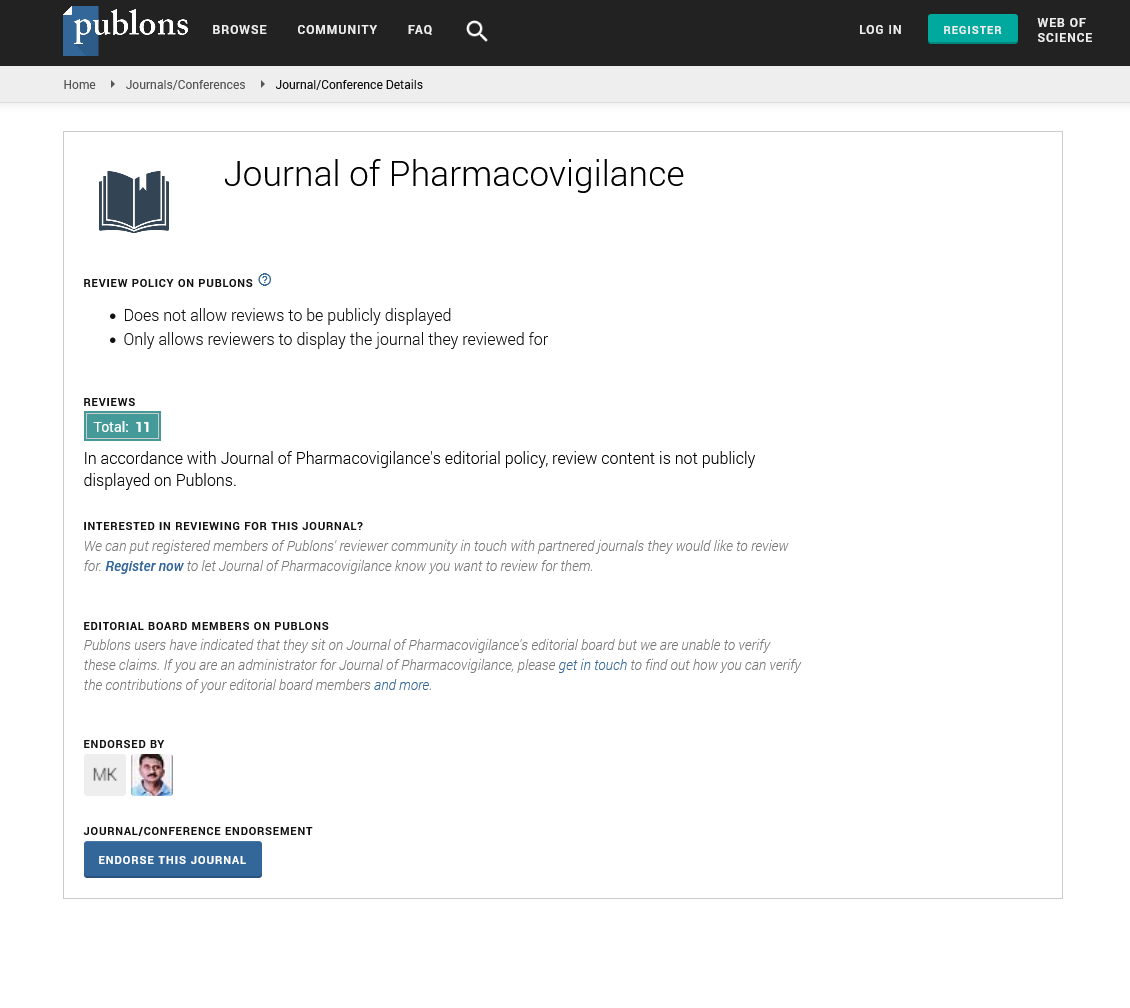Indexed In
- Open J Gate
- JournalTOCs
- The Global Impact Factor (GIF)
- RefSeek
- Hamdard University
- EBSCO A-Z
- OCLC- WorldCat
- Publons
- Euro Pub
- Google Scholar
Useful Links
Share This Page
Journal Flyer

Open Access Journals
- Agri and Aquaculture
- Biochemistry
- Bioinformatics & Systems Biology
- Business & Management
- Chemistry
- Clinical Sciences
- Engineering
- Food & Nutrition
- General Science
- Genetics & Molecular Biology
- Immunology & Microbiology
- Medical Sciences
- Neuroscience & Psychology
- Nursing & Health Care
- Pharmaceutical Sciences
Perspective - (2024) Volume 12, Issue 2
Pharmacovigilance of Medications for Antimicrobial Resistance Management
Nishikiori Nami*Received: 29-May-2024, Manuscript No. JP-24-25988; Editor assigned: 31-May-2024, Pre QC No. JP-24-25988(PQ); Reviewed: 14-Jun-2024, QC No. JP-24-25988; Revised: 21-Jun-2024, Manuscript No. JP-24-25988(R); Published: 28-Jun-2024, DOI: 10.35248/2329-6887.24.12.481
About the Study
The Antimicrobial Resistance (AMR) necessitates a multi-pronged approach to safeguard the efficacy of antibiotics and other antimicrobials. Pharmacovigilance, the science of monitoring medication safety and efficacy, emerges as a critical tool in this fight. By actively monitoring the use and outcomes of antimicrobials, pharmacovigilance provides valuable insights into:
Adverse Drug Reactions (ADRs) associated with antimicrobials, which may indirectly contribute to resistance development. Trends in therapeutic failure, potentially indicative of emerging or established resistance mechanisms. Patterns of antimicrobial use, including over-prescription, off-label use, and noncompliance, all significant drivers of AMR.
This manuscript explores the significance of pharmacovigilance for antimicrobials, highlighting key strategies for effective monitoring and risk assessment. We delve into the specific challenges encountered in the context of AMR and propose recommendations for optimizing pharmacovigilance's role in tackling this global health crisis.
The specter of Antimicrobial Resistance (AMR) looms large, jeopardizing our ability to treat infectious diseases effectively. The World Health Organization (WHO) has designated AMR as a top ten global health threat, emphasizing the urgent need for a coordinated international response.
Pharmacovigilance, the systematic monitoring of the safety and efficacy of medications, plays a pivotal role in combating AMR. By actively monitoring the use and outcomes associated with antimicrobials, pharmacovigilance can offer invaluable insights.
Certain ADRs, such as those affecting the kidneys or gastrointestinal system, can indirectly contribute to AMR. For instance, nephrotoxic drugs may necessitate dose reductions or discontinuation of antimicrobials, leading to suboptimal treatment and potentially promoting resistance selection.
An increase in therapeutic failures with specific antimicrobials can be emerging or established resistance mechanisms. By identifying these trends, pharmacovigilance can inform clinical practice and public health interventions.
Inappropriate use of antimicrobials, encompassing overprescription, off-label use, and non-compliance with dosing regimens, is a major driver of AMR. Pharmacovigilance can identify such patterns and inform the development of strong antimicrobial stewardship programs.
Several strategies can be employed to optimize pharmacovigilance for antimicrobials in the context of AMR. Encouraging healthcare professionals and patients to report suspected ADRs and therapeutic failures associated with antimicrobials is crucial.
Implementing targeted surveillance programs for high-risk antimicrobials, specific patient populations, or emerging resistance threats can provide valuable insights. Employing data mining techniques to analyze large datasets of pharmacovigilance data can help identify potential safety signals associated with AMR. Effective collaboration between national and international pharmacovigilance agencies, as well as with research institutions, is essential for timely dissemination of information on emerging resistance trends.
Despite its importance, pharmacovigilance for antimicrobials faces certain challenges. Underreporting of suspected ADRs and therapeutic failures remains a significant issue. Data collected through spontaneous reporting systems can be prone to bias and inconsistency. Many countries, particularly low- and middleincome countries, lack the resources to implement strong pharmacovigilance programs.
Educational initiatives for healthcare professionals and patients can increase awareness of the importance of reporting ADRs and treatment failures. Adopting standardized reporting formats and terminologies can improve data quality and facilitate international collaboration. Investing in training and infrastructure development can strengthen pharmacovigilance capabilities in resource-limited settings.
Conclusion
Pharmacovigilance serves as a fundamental in combating AMR by monitoring the safety and efficacy of antimicrobials. By effectively identifying potential safety signals, tracking therapeutic failure trends, and monitoring patterns of use, pharmacovigilance can inform clinical practice, guide public health interventions, and ultimately contribute to the development of new antimicrobials and stewardship strategies. As the threat of AMR continues to escalate, optimizing pharmacovigilance initiatives and encouraginging international collaboration are significant steps towards a more sustainable future for antimicrobial therapy.
Citation: Nami N (2024) Pharmacovigilance of Medications for Antimicrobial Resistance Management. J Pharmacovigil. 12:481.
Copyright: © 2024 Nami N. This is an open-access article distributed under the terms of the Creative Commons Attribution License, which permits unrestricted use, distribution, and reproduction in any medium, provided the original author and source are credited.

